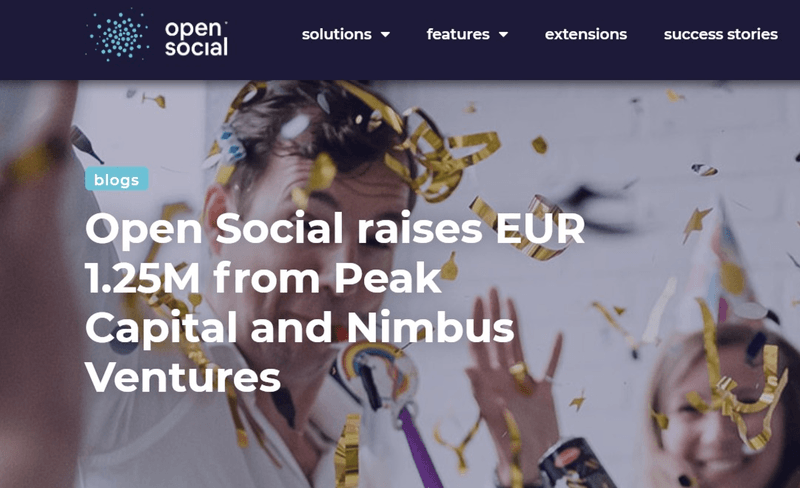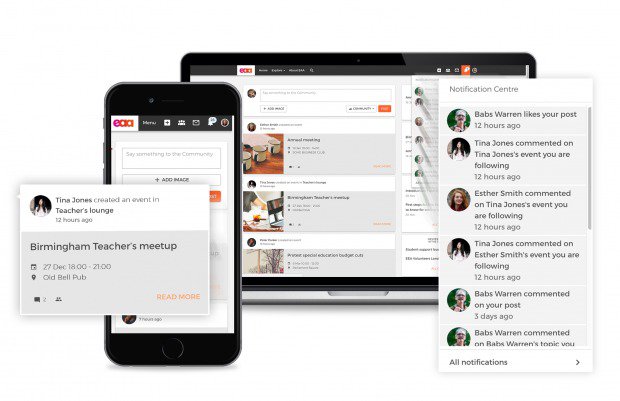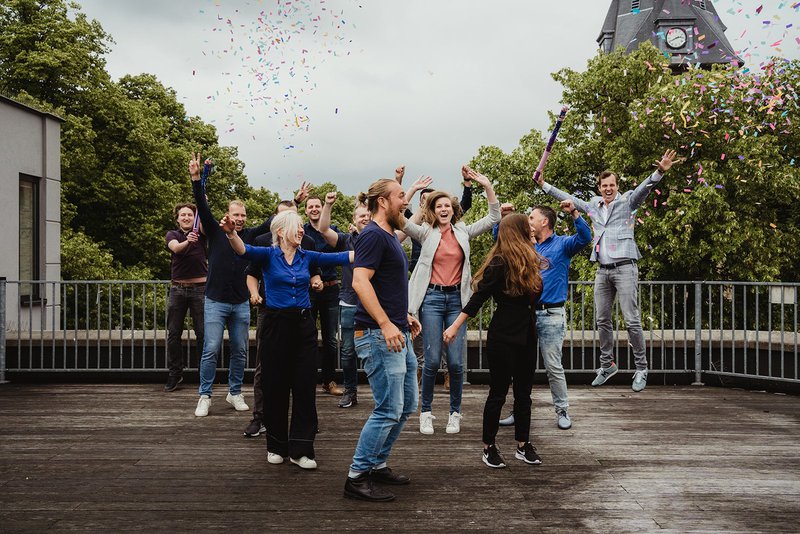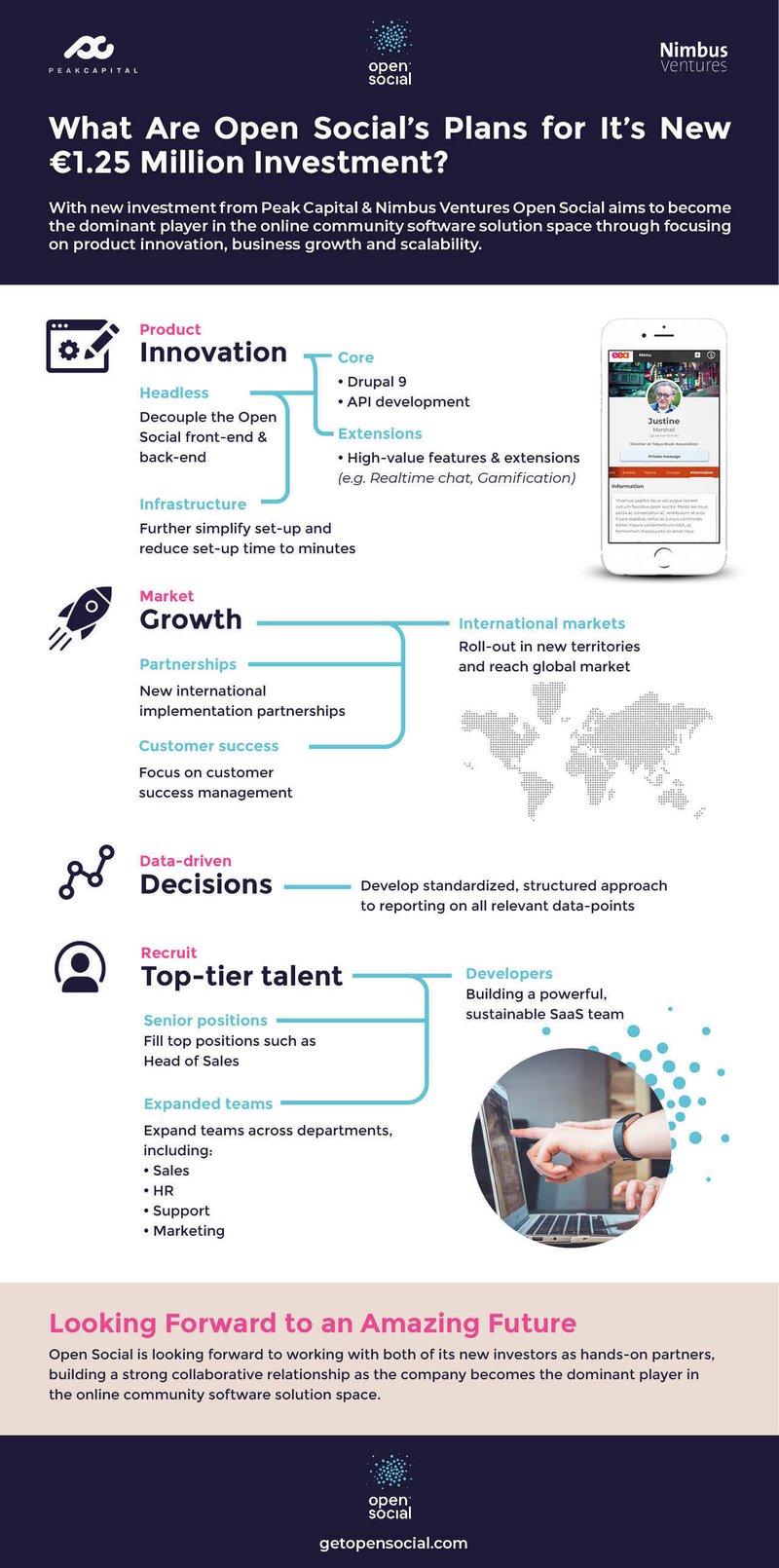
A little while back, we (Peak and Nimbus Ventures) announced our joint investment in Open Social. In this blog post, we are sharing our rationale behind this investment.
How it all began…
We first met the Open Social team at The Next Web Conference in 2019 after reaching out to them earlier that year. We heard through the grapevine that they were working on something awesome. That turned out to be an online community engagement platform for global organizations such as NGOs and other public institutions.
At the time, the team was operating as a software agency. However, they dreamed of shifting to a SaaS solution built on top of Drupal, a popular open-source platform. This shift would allow them to build a broadly applicable platform (vs more customized demands from agency customers) and to start charging recurring revenue (vs one-off agency fees). In the 18 months between first meeting the team and our investment, we witnessed how the team successfully managed this shift (more on that below), which was a big factor in our investment decision.
Ok, so what does Open Social do?
Organizations need to figure out a new way how to interact with their community. Emailing is dead… newsletters have low engagement rates, Facebook takes control over your community’s data, and other community tools are either too limited or have a horrible UX. Enter: Open Social.

Open Social provides NGOs and public organizations with a modular SaaS platform to manage their community, knowledge, and networks (of volunteers, members, fans, experts, etc). They help organizations with three primary solutions: Knowledge Portal, Social Learning, and Online Community.
As the name may suggest, Open Social is open-source and built on top of the popular open-source platform, Drupal. Thousands of organizations are using the free Drupal platform and develop it further in return. Open Social’s Open Core is a paid platform that organizations like the United Nations, European Commission, and Greenpeace use to improve their engagement and knowledge sharing. As part of its product, Open Socials also provides a marketplace for extensions.
Why are we excited about the Open Social team?
As always, the team is a vital driver in our investment decision. Hard-working founders, Taco Potze and Bram ten Hove, have built Open Social. Sjoerd Pijnappel heads Marketing and Roel Cozijnse recently joined the team as Head of Sales. They have offices in Amsterdam and in Enschede, where the company was founded during Taco’s study at the University of Twente.
A flawlessly executed “SaaSification”
We had the unique opportunity to get to know founders over a longer period of time and observe how they handled their “SaaSification”. We see a lot of SaaS companies that start as agencies and want to scale their business by “SaaSifying” their way of working. Starting as an agency can be positive as you already have an established client base, but the switch to SaaS is not always easy.
We see first hand how difficult this can be, and identified three difficulties in “SaaSifying”:
- Commercial: Clients are used to being fully served by agencies to meet their specific needs (think: custom features, professional services, etc). The switch to SaaS means clients have to work with a set product. If they have specific needs, they need another party involved or to do it themselves.
- Financial: Working as an agency can make you “addicted” to the direct cash it brings in when you acquire a client or deliver your solution. SaaS, by nature, brings in cash for value over a longer period of time. Meaning that at first, you’ll have to do more work for way less cash. This is a long-term game, the team must remind themselves that a SaaS model means you’ll be more scalable, be able to serve more clients, and thus will win in the long run.
- And above all, your team’s mind- and skillset has to change. With an agency, you’re used to say “yes we can” to fully please the client. Your team has more project-oriented people. With scaling SaaS, you have to be hyper-focused in order to find product-market-fit and scale your company. This means saying “no”. In addition, you’ll need go-getting salespeople on the one end and outstanding product people on the other end. This leaves the talented project-based people in the dark…
An admirable work ethic
We particularly appreciate the team’s structured way of working, which we had the pleasure to witness in the time before the investment. The Open Social team nailed every meeting with solid preparation and answered all open questions – even before they were asked. They navigated critical discussions thoroughly, like the market opportunity at large, which demonstrated an analytical mindset and long-term perspective. Pivots can be hard, but they handled it with the thoroughness and grace of experienced founders.

A look at the open source space
Over the past several years, we’ve seen a growing number of successful open-source companies like Elastic and GitHub, which was acquired by Microsoft. Open-Source is an increasingly hot space with annual invested capital in open-source increasing at a roughly 10% compounded annual growth rate (CAGR) over the last five years (Crunchbase). The attractive returns in the space seem to be adding more fuel to the fire, as open-source and developer tool startups saw more than $2 billion invested in the space in 2019 alone ( TechCrunch).
The open-source market model has proven to be more and more commercial. Large organizations are gradually following an open-source first approach, as developers become more influential in buying decisions and businesses look for more control and customization in software.
This means that small teams can gain global traction on both developer and commercial power by tapping into the open-source developer communities – and at a fraction of the cost one would normally need to do so. Covid-19 will help to accelerate this. Due to their decentralized nature, open-source companies will easier embrace remote development and organic promotion by individual users and teams.
Cost and control are other elements driving the growing popularity of open-source models. Most of the time, it’s better value for money while also providing access to more customization than closed solutions. These are winning elements when companies across the board need to save on their software spend and want more control over their environments.
What is interesting about Open Social’s market?
We are enthusiastic about Open Social’s unique focus on NGOs and public organizations like government, universities, local authorities, etc. These organizations have clear long term goals and require communities to actively manage their target audience. Remote work has been a defining feature of NGOs, who work with large and decentralized networks of civilians, volunteers, and members. They need to organize these communities in a scalable way. Through COVID-19, the public sector is growing and increasingly remote. We expect this to be a long-term situation, which creates an attractive market for Open Social.
Technology <> market fit
The public sector is seeing more demand for an ‘open-source first’ approach. Here, customers do not want to be dependent on big commercial players from the US that have a different approach to privacy and often pay less attention to elements like environment and welfare; these elements are high on an NGO’s list. As they don’t have the capacity to build a platform themselves, they embrace the open-source vision to stay in control with customization possibilities.
Open Social services thousands of clients worldwide. Leading brands like the United Nations, European Commission, Greenpeace, and The Salvation army have chosen Open Social as their leading community platform.
In conclusion…
We are impressed by the team’s vision and execution ability in shifting from an agency to a SaaS company. We see a big opportunity in unlocking the open-source market to provide NGO and non-profit organizations with flexible and scalable solutions to enhance their communication and knowledge sharing.
We’re excited to work with the Open Social team to realize the big opportunity ahead of us. What’s next? Take a look. below:

– Written by Johan van Mil at Peak and Auke van den Hout from Nimbus Ventures.
